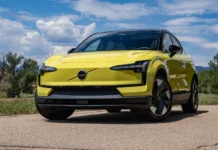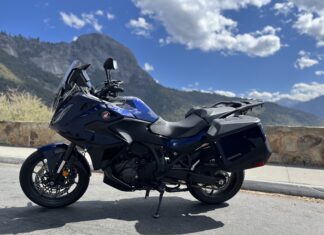
It’s not the “Tornado”, but this new engine is still a force to be reckoned with.
With all the talk of electric vehicles and the shift away from internal combustion development, it’s certainly a change of pace to see a brand new engine emerge. And yet, that’s exactly what we have here, as Stellantis finally reveals its all-new Hurricane 3.0-liter inline-six. It’s the first clean-sheet engine the automaker’s launched in quite awhile, and it’s meant to offer V8 levels of power, while also substantially reducing CO2 emissions and improving fuel economy.
So, what of the earlier rumors are true, and what’s changed from what we thought we knew?
Two distinct engines with 400 – 500 horsepower
Head of Global Propulsion Micky Bly gave substantial insight into Stellantis’ new powertrain, as well as the rationale behind why the company developed it in the first place. Engineers began working on this design back in 2019, and the first GME-T6 (Global Medium Engine – Turbo 6) units did indeed make it into production at the company’s Saltillo, Mexico plant in November 2021. Bly noted that while Stellantis is going full speed ahead toward electric drivetrains, their customers’ specific needs still necessitate an internal combustion solution, at least in the near-term.
To accommodate those needs, the 3.0-liter Hurricane inline-six will arrive in Stellantis vehicles later this year, in two states of tune. The ‘SO’ (Standard Output) engine, per the company’s official statement, will put out “more than 400 horsepower” and 450 lb-ft of torque, per SAE standard J2723. The company notes it optimized the unit more for efficiency, with two smaller turbochargers, lower maximum boost pressure (22 psi) and a higher 10.4:1 compression ratio. The Hurricane SO engine can run on 87 octane fuel, though the automaker recommends premium for the best figures possible.
The ‘HO’ — or High Output — engine will make “more than 500 horsepower”, and above 475 lb-ft of torque. This version uses larger turbochargers and outputs higher max boost (26 psi). Engineers tuned this powerplant for performance, and as such lowered the compression ratio to 9.5:1. The Hurricane HO requires premium fuel, while the 350-bar (5,075 psi) direct injection system delivers gas to each of the six cylinders through two chain-driven pumps (one on the SO engine).
Stellantis says both engines have a broad, flat torque curve between 2,850 RPM and the redline. On the SO version, the redline is electronically limited to 5,800 RPM, while the HO engine revs up to 6,100 RPM.
Both Hurricane engines share several components
In an effort to scale production — Stellantis is aiming to build up to 250,000 of these engines every year at their Saltillo North Engine Plant — both the SO and HO versions of the Hurricane inline-six share 96 common parts. The differences between the two engines pertain mainly to the changes in power or in application. Components like turbochargers, intercoolers and some other minor changes will be different between the two engines.
Both versions of the 3.0-liter Hurricane inline-six use a lightweight, deep-skirt cast aluminum block with cross-bolted steel main bearing caps. The engines also use a die-cast aluminum alloy oil pain and head as well as a pent-roof combustion chamber (not a hemispherical one). The crankshaft and connecting rods are forged steel, while the pistons themselves are forged aluminum alloy.
One notable change with the new Hurricane engine design is with its cylinder coating. Instead of cast iron, cast steel or forged alloy cylinder liners, Stellantis’ new engine uses ‘Plasma Transfer Wire Arc’ (or spray bore) technology to spray each cylinder with a permanently bonded coating. The process melts a steel alloy wire at 2,300 degrees Celsius (4,150 degrees Fahrenheit), then sprays microscopic particles directly onto the cylinder walls. After extensive durability testing, Bly says that PTWA coating offers 10-times better wear resistance, as well as better efficiency thanks to lower friction losses for the individual pistons.
These engines share a common bore and stroke (3.31 x 3.54 inches, or 84 x 90 mm), as well as similar cylinder spacing to Stellantis’ existing 2.0-liter turbocharged four-cylinder engine, currently used in the Jeep Wrangler, Cherokee and Grand Cherokee 4xe.

The Hurricane can be electrified, but it won’t be at first
Overall, Stellantis says the 3.0-liter inline-six Hurricane on its own will cut 13-15% CO2 emissions from the company’s long-lived 5.7-liter Hemi V8. On top of that, even the SO version will deliver more power and torque, at 133 horsepower per liter. The HO engine, for its part, can manage at least 166 horsepower per liter, according to the automaker’s preliminary specs.
Exact horsepower and torque figures will depend on the specific application. Stellantis plans to roll this engine out across its North American brands, with the most likely candidates to receive this engine first being the Ram 1500 and the Jeep Wagoneer/Grand Wagoneer. Company spokespeople did not confirm where you will see the Hurricane first — those announcements are coming in the next few months. However, in the future the Hurricane will power ‘STLA Large’ and ‘STLA Frame’ platform vehicles.
Neither version of the Hurricane will be electrified at launch. Both versions of the Hurricane engines hitting dealers later this year will have an engine start-stop function, again to improve fuel economy.
That said, engineers did design the engine with electrification in mind, so it can support HEV or plug-in hybrid applications. That will likely come into play as emissions regulations continue to tighten, but the byproduct of that could be even more power and torque down the line.
Stay tuned for more updates!
This week’s Hurricane reveal is just the tip of the iceberg, and we should have much more brand-specific information over the next several months. Stay tuned to TFL Studios for all that information as soon as we get it.
This article is also posted on TFLtruck.com.

























